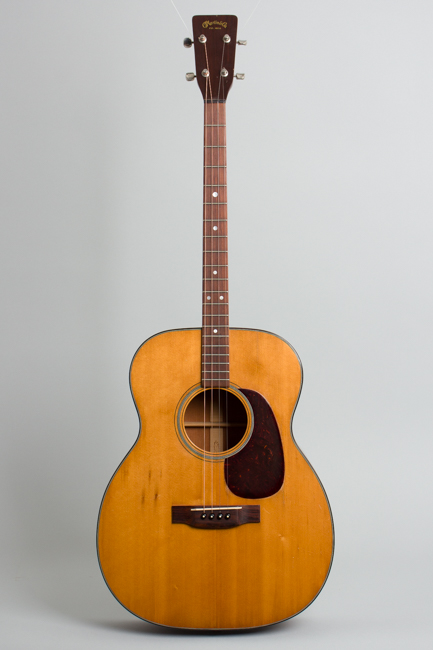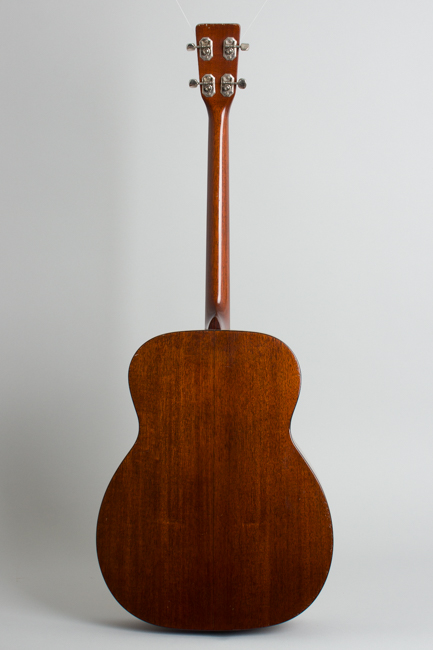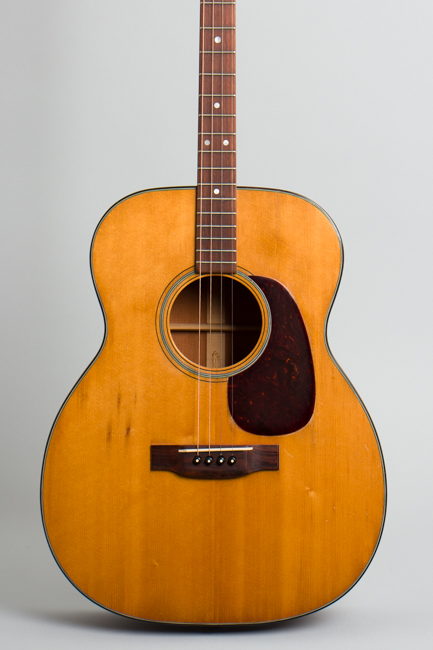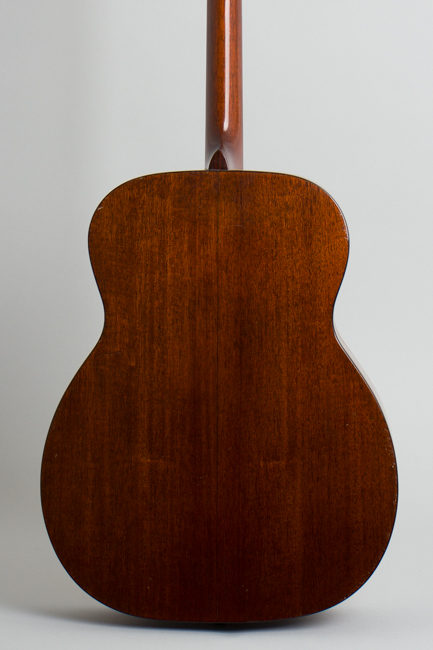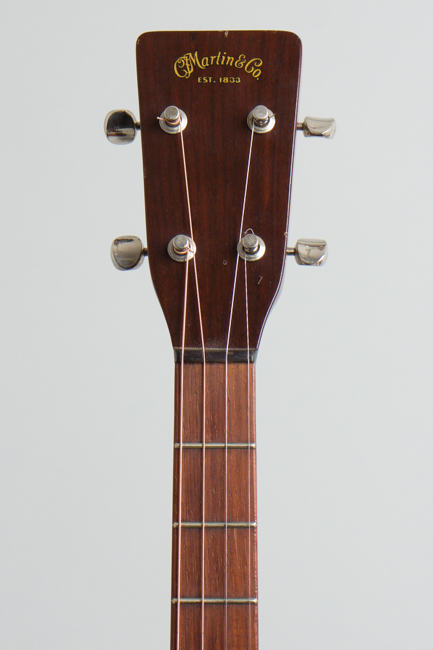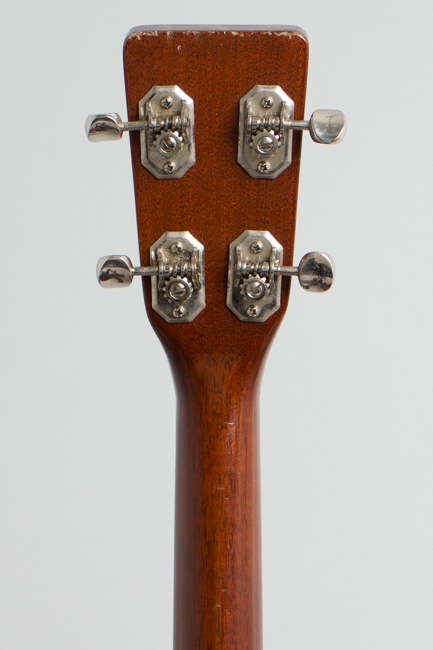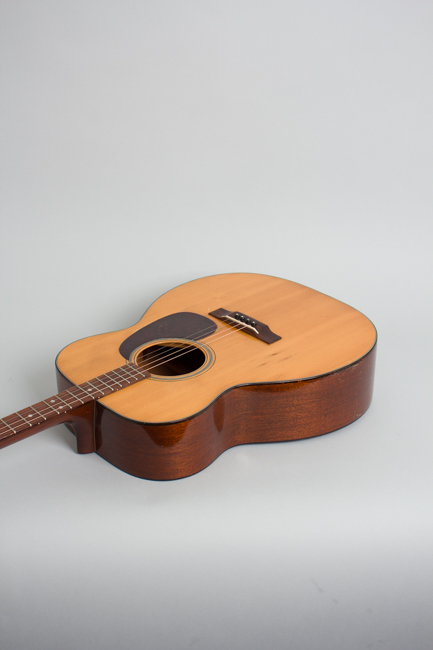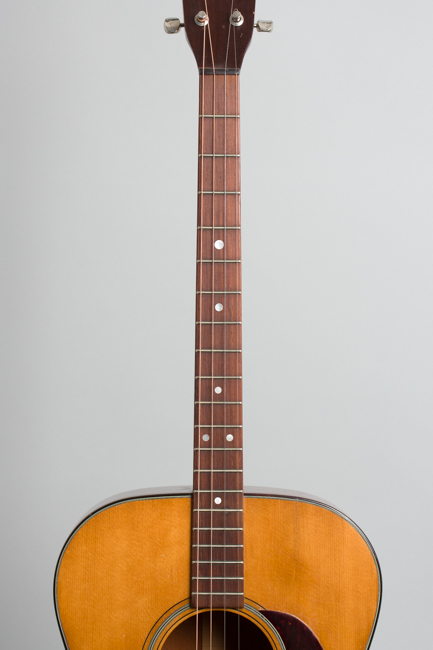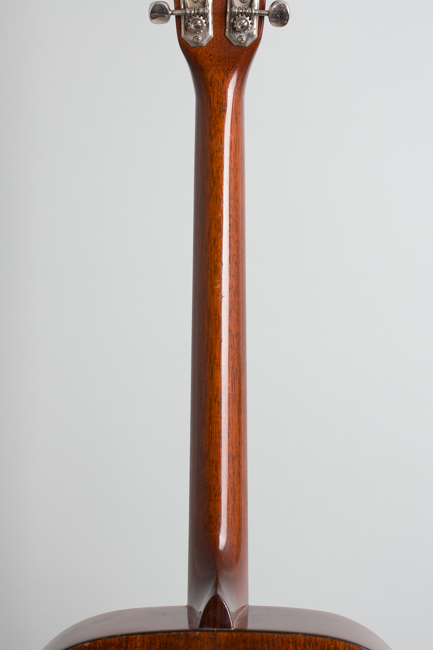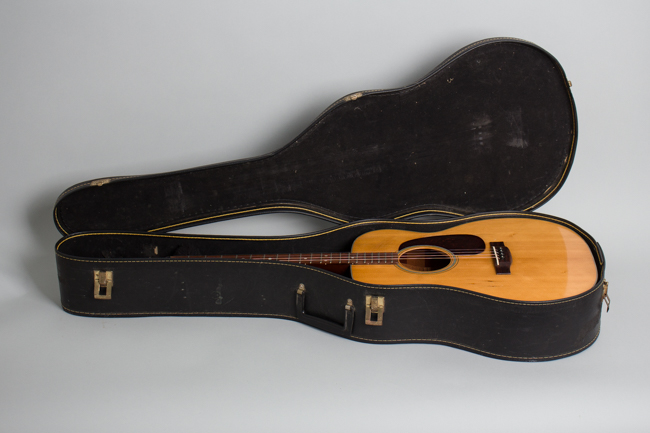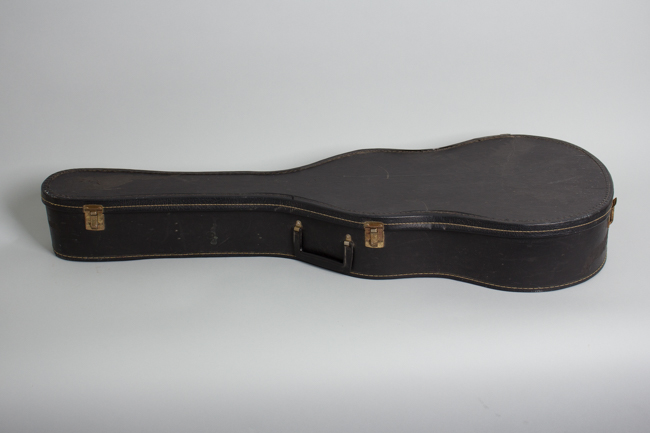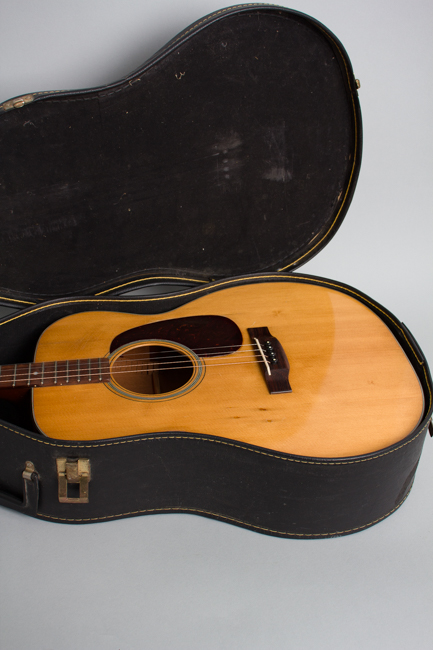C. F. Martin 0-18T Flat Top Tenor Guitar (1952)
C. F. Martin 0-18T Model Flat Top Tenor Guitar (1952), made in Nazareth, PA, serial # 125618, natural lacquer finish, mahogany back, sides and neck, spruce top, rosewood fingerboard, black chipboard case.
The Martin 0-18T is one of the finest and most popular tenor guitars ever made, a lovely and well-balanced design. This one is a bit worn in but a very good player. It dates to the early 1950's, sometime before the "Folk" boom really took off. When the Kingston Trio hit BIG in 1958-9, the 0-18T was along for the ride in the hands of group member Nick Reynolds. Folk groups who emulated the Trio's sound wanted one in their arsenal and the model definitely had a boost in popularity for a few years.
This 0-18T shows typical Style 18 Martin features including a spruce top, mahogany back and sides, rosewood belly bridge and fingerboard, teardrop celluloid pickguard and 14 fret 23" scale neck. The Brazilian rosewood-faced headstock has a small "C. F. Martin" decal logo and open back large-plate Kluson tuners. The spruce used for the top has some small figure spots one would not normally expect to see on a Martin of this period, but as the 0-18T was one of their smallest and less expensive instruments it must have been deemed OK .
The Martin tenor has experienced upswings and downtimes in popularity over the last century. Designed in the late 1920s for tenor banjoists getting pushed out of work by the guitar, tenor guitars like this 0-18T can be tuned in the "correct" fifths tenor tuning (C-G-D-A) or simply as the higher four guitar strings (D-G-B-E) or beyond. In the 1930's long before the Kingston Trio Rabon Delmore used small tenor Martin models including the 0-18T to play deftly picked leads on the Delmore Brothers' records, and while others have explored them since they offer a range of possibilities to this day still not fully explored.
Overall length is 35 1/2 in. (90.2 cm.), 13 1/2 in. (34.3 cm.) wide at lower bout, and 4 1/8 in. (10.5 cm.) in depth at side, taken at the end block. Scale length is 23 in. (584 mm.). Width of nut is 1 1/4 in. (32 mm.).
For 72 years along this Martin is in decent shape, although it has had some wear, repair and cosmetic touch-up generally making it more of a "gigger" than a collector's piece. The original lacquer finish survives intact; the top has some touch-up work over several case lid bites above and in front of the bridge. The finish overall has dings, dents and scrapes but no really heavy wear. The neck finish is comparatively clean with a few tiny dings and dents.
Repairs include a small sealed punch mark on the turn of the lower bout side above the endpin that has been secured and lightly touched up. The top has several minor grain cracks; one directly above and one below the outside edges of the celluloid pickguard (which has a tendency to peel up over time). These are sealed with some light overfinish. There is one other neat spruce grain split on the upper treble bout, running back from the front edge binding. There are no other crack repairs. Internally, all original bracing and the original thin maple bridge plate are intact, with what appears to be a factory installed cleat behind it along the center seam.
The original bridge has been VERY slightly lowered and the saddle appears newer. The frets are original and show very little wear. No strap button has ever been installed. Although cosmetically this little Martin is not perfect it is an excellent player and a sweet and surprisingly powerful sounding guitar. It resides in a later chipboard case. Very Good + Condition.
The Martin 0-18T is one of the finest and most popular tenor guitars ever made, a lovely and well-balanced design. This one is a bit worn in but a very good player. It dates to the early 1950's, sometime before the "Folk" boom really took off. When the Kingston Trio hit BIG in 1958-9, the 0-18T was along for the ride in the hands of group member Nick Reynolds. Folk groups who emulated the Trio's sound wanted one in their arsenal and the model definitely had a boost in popularity for a few years.
This 0-18T shows typical Style 18 Martin features including a spruce top, mahogany back and sides, rosewood belly bridge and fingerboard, teardrop celluloid pickguard and 14 fret 23" scale neck. The Brazilian rosewood-faced headstock has a small "C. F. Martin" decal logo and open back large-plate Kluson tuners. The spruce used for the top has some small figure spots one would not normally expect to see on a Martin of this period, but as the 0-18T was one of their smallest and less expensive instruments it must have been deemed OK .
The Martin tenor has experienced upswings and downtimes in popularity over the last century. Designed in the late 1920s for tenor banjoists getting pushed out of work by the guitar, tenor guitars like this 0-18T can be tuned in the "correct" fifths tenor tuning (C-G-D-A) or simply as the higher four guitar strings (D-G-B-E) or beyond. In the 1930's long before the Kingston Trio Rabon Delmore used small tenor Martin models including the 0-18T to play deftly picked leads on the Delmore Brothers' records, and while others have explored them since they offer a range of possibilities to this day still not fully explored.
Overall length is 35 1/2 in. (90.2 cm.), 13 1/2 in. (34.3 cm.) wide at lower bout, and 4 1/8 in. (10.5 cm.) in depth at side, taken at the end block. Scale length is 23 in. (584 mm.). Width of nut is 1 1/4 in. (32 mm.).
For 72 years along this Martin is in decent shape, although it has had some wear, repair and cosmetic touch-up generally making it more of a "gigger" than a collector's piece. The original lacquer finish survives intact; the top has some touch-up work over several case lid bites above and in front of the bridge. The finish overall has dings, dents and scrapes but no really heavy wear. The neck finish is comparatively clean with a few tiny dings and dents.
Repairs include a small sealed punch mark on the turn of the lower bout side above the endpin that has been secured and lightly touched up. The top has several minor grain cracks; one directly above and one below the outside edges of the celluloid pickguard (which has a tendency to peel up over time). These are sealed with some light overfinish. There is one other neat spruce grain split on the upper treble bout, running back from the front edge binding. There are no other crack repairs. Internally, all original bracing and the original thin maple bridge plate are intact, with what appears to be a factory installed cleat behind it along the center seam.
The original bridge has been VERY slightly lowered and the saddle appears newer. The frets are original and show very little wear. No strap button has ever been installed. Although cosmetically this little Martin is not perfect it is an excellent player and a sweet and surprisingly powerful sounding guitar. It resides in a later chipboard case. Very Good + Condition.
